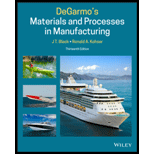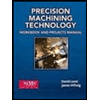
Degarmo's Materials And Processes In Manufacturing
13th Edition
ISBN: 9781119492825
Author: Black, J. Temple, Kohser, Ronald A., Author.
Publisher: Wiley,
expand_more
expand_more
format_list_bulleted
Textbook Question
Chapter 27, Problem 26RQ
What is the difference between the roughing teeth and the finishing teeth in a typical pull broach?
Expert Solution & Answer
Want to see the full answer?
Check out a sample textbook solution
Students have asked these similar questions
Machining time required reduce a mild steel rod of diameter 60mm, initial length (L) 125mm to final length (L1) 120mm to 58 mm by turning a carbide insert. If the approach length and over run length are 5 mm and 1 mm respectively, take Cutting speed as 20 m/min and feed is =0.2 mm/rev, and the depth of cut is 0.5mm
Is a #6 twist drill larger than a #16 twist drill?
What is the diameter of both twisting screws?
Identify and explain the method of milling process in which the stresses on the teeth is maximum at the end of the cut with neat diagram.
Chapter 27 Solutions
Degarmo's Materials And Processes In Manufacturing
Ch. 27 - Why is sawing one of the most efficient of the...Ch. 27 - Explain why tooth spacing (pitch) is important in...Ch. 27 - What is the tooth gullet used for on a saw blade?Ch. 27 - Explain what is meant by the set of the teeth on a...Ch. 27 - How is tooth set related to saw kerf?Ch. 27 - Why can a bandsaw blade not be hardened throughout...Ch. 27 - What are the advantages of using circular saws?Ch. 27 - Why have bandsawing machines largely replaced...Ch. 27 - Explain how the hole in Figure 27.7 is made on a...Ch. 27 - How would you calculate or estimate Tm for a...
Ch. 27 - What is the disadvantage of using gravity to feed...Ch. 27 - What is unique about the broaching process...Ch. 27 - Can a thick saw blade be used as a broach? Why or...Ch. 27 - Broaching machines are simpler in a basic design...Ch. 27 - Why is broaching particularly well-suited for mass...Ch. 27 - In designing a broach, what would be the first...Ch. 27 - Why is it necessary to relate the design of a...Ch. 27 - What two methods can be utilized to reduce the...Ch. 27 - For a given job, how would a broach having...Ch. 27 - Why are the pitch and radius of the gullet between...Ch. 27 - Why are broaching speeds usually relatively low,...Ch. 27 - What are the advantages of shell-type broach...Ch. 27 - Why are most broaches made from alloy or...Ch. 27 - What are the advantages of TiN-coated broaching...Ch. 27 - For mass-production operations, which process is...Ch. 27 - What is the difference between the roughing teeth...Ch. 27 - The sides of a square, blind hole must be machined...Ch. 27 - The interior, flat surfaces of socket wrenches,...Ch. 27 - Prob. 29RQCh. 27 - What are some ways to improve the efficiency of a...Ch. 27 - To what extent is filing different from sawing?Ch. 27 - Prob. 32RQCh. 27 - Prob. 33RQCh. 27 - Prob. 34RQCh. 27 - A surface 12 in. long is to be machined with a...Ch. 27 - The pitch of the teeth on a simple surface broach...Ch. 27 - Estimate the (approximate maximum) horsepower...Ch. 27 - Estimate the approximate force acting in the...Ch. 27 - In cutting a 6-in.-long slot in a piece of AISI...Ch. 27 - The strength of a pull broach is determined by its...Ch. 27 - Suppose you want to shape a block of metal 7 in....Ch. 27 - Could you have saved any time in Problem 7 by...Ch. 27 - Derive the equation for shaping cutting speed.Ch. 27 - How many strokes per minute would be required to...Ch. 27 - How much time would be required to shape a flat...Ch. 27 - What is the metal removal rate in Problem 11 if...Ch. 27 - Suppose you decide to mill the flat surface...Ch. 27 - A planer has a 10-hp motor, and 75% of the motor...
Additional Engineering Textbook Solutions
Find more solutions based on key concepts
The strain at point A on the bracket has components x = 300(106), y = 550(106), xy = 650(106), z = 0, Determine...
Mechanics of Materials (10th Edition)
The expression for the rate at which useful heat is collected per unit area of the collector and also find the ...
Introduction to Heat Transfer
When force P is applied to the rigid arm ABC, point B displaces vertically downward through a distance of 0.2 m...
Mechanics of Materials
The design condition for a space is 77 F (25 C) db and 50 percent relative humidity with 55 F (13 C) db supply ...
Heating Ventilating and Air Conditioning: Analysis and Design
A healing contractor must heat 0.2kg/s of water from 15C to 35C using hot gases in cross flow over a thin walle...
Fundamentals of Heat and Mass Transfer
A piece of experimental apparatus. Fig. P1.54. is located where g=9.5m/s2 and the temperature is 5C . Air flow ...
Fundamentals Of Thermodynamics
Knowledge Booster
Learn more about
Need a deep-dive on the concept behind this application? Look no further. Learn more about this topic, mechanical-engineering and related others by exploring similar questions and additional content below.Similar questions
- During orthogonal cutting of mild steel with a 10° rake angle tool, the chip thickness ratio was obtained as 0.4 .Calaculate the shear angle.arrow_forwardWhy proper selection of cutting speed is important in machining? What is the main advantage of a turret lathe over to engine lathe? Give advantages of horizontal band saw over reciprocating power hacksaw. What is the difference in drilling operation using a drill press and lathe?arrow_forwardWith neat sketch explain the tap drill nomenclature?arrow_forward
- List all the failure modes, wear mechanisms and wear conditions for cutting toolsarrow_forwardwith neat sketch explain any three different types mandrels used in a lathe. Why is it used?arrow_forwardA single-point HSS tool with a 3/64 in nose radius isused in a shaping operation on a ductile steel workpart.The cutting speed is 120 ft/min. The feed is 0.014 in/pass and depth of cut is 0.135 in. Determine the surfaceroughness for this operation.arrow_forward
- The vertical band saw is particularly useful, as it can be used to make straight cuts as well as ______________.arrow_forwardwhat did you recommend for better grinding lathe tools?arrow_forwardA drilling operation is to be carried out with a 12.7mm diameter twist drill in a steel work part.The hole is a blind hole of 50mm depth. The cutting speed is 25mm/min and the feed is 0.3mm/rev Determine the following i)Cutting time to complete the driling ii)Metal removal ratearrow_forward
arrow_back_ios
SEE MORE QUESTIONS
arrow_forward_ios
Recommended textbooks for you
 Precision Machining Technology (MindTap Course Li...Mechanical EngineeringISBN:9781285444543Author:Peter J. Hoffman, Eric S. Hopewell, Brian JanesPublisher:Cengage Learning
Precision Machining Technology (MindTap Course Li...Mechanical EngineeringISBN:9781285444543Author:Peter J. Hoffman, Eric S. Hopewell, Brian JanesPublisher:Cengage Learning

Precision Machining Technology (MindTap Course Li...
Mechanical Engineering
ISBN:9781285444543
Author:Peter J. Hoffman, Eric S. Hopewell, Brian Janes
Publisher:Cengage Learning
HOME SHOP JIGS & FIXTURES PART 1, TYPES OF JIGS & ACCESSORIES AND THE THEORIE BEHIND THE TOOLS; Author: THATLAZYMACHINIST;https://www.youtube.com/watch?v=EXYqi42JimI;License: Standard Youtube License